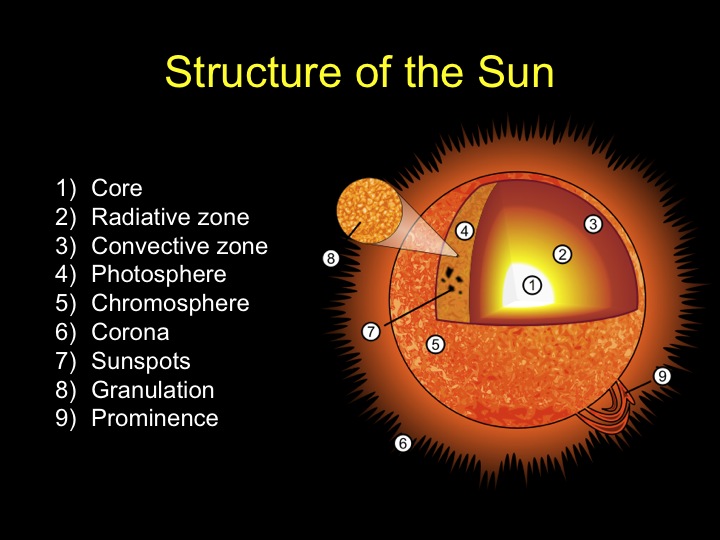General Science Notes On – Internal Structure Of Sun – For W.B.C.S. Examination.
The energy radiated by the Sun is produced during the conversion of hydrogen (H) atoms to helium (He). The Sun is at least 90 percent hydrogen by number of atoms, so the fuel is readily available.Continue Reading General Science Notes On – Internal Structure Of Sun – For W.B.C.S. Examination.
Since one hydrogen atom weighs 1.0078 atomic mass units and a single helium atom weighs 4.0026, the conversion of four hydrogen atoms to one helium atom yields 0.0294 mass unit, which are all converted to energy, 6.8 million electron volts (MeV, 1 MeV = 1.6 × 10−6 erg), in the form of gamma (γ) rays or the kinetic energy of the products. If all the hydrogen is converted, 0.7 percent of the mass becomes energy, according to the Einstein formula E = mc2, in which E represents the energy, m is the mass, and c is the speed of light.
A calculation of the time required to convert all the hydrogen in the Sun provides an estimate of the length of time for which the Sun can continue to radiate energy. In only about 10 percent of the Sun are the temperatures high enough to sustain fusion reactions. Converting 0.7 percent of the 2 × 1032 grams of hydrogen into energy that is radiated at 4 × 1033 ergs per second permits the Sun to shine for 3 × 1017 seconds, or 10 billion years at the present rate.
The Sun can be split into two regions:
- The interior is a sphere with radius R = 7×108m
- The atmosphere lies on top and has the following layers (from innermost to outermost):
- The photosphere is about 300 km thick. Most of the Sun’s visible light that we see originates from this region.
- The chromosphere is about 2000 km thick. We only see this layer and the other outer layers during an eclipse.
- The corona extends outwards for more than a solar radius.
- Balance of forces between Gravity and Pressure – hydrostatic equilibrium
- Balance of energy produced and radiated away – thermal equilibrium
- Nuclear fusion in a stellar core as a source of energy.
Density of water = 999.97 kg/m³ = ~ 1 g/cm3;
Density of Iron = 7870 kg/m³.
That implies Iron is = 7.87 times denser than water. In comparison, earth is about 5.5 times denser than water.
- The surface gravity of the Sun is 274 m/s2 (28 times the gravity of the Earth).
- Comparatively, the surface gravity of the earth and moon are 9.8 m/s2 and 1.62 m/s2 respectively.
- Period of rotation: 25 days 9 hrs.
- Speed of rotation: 7179.73 km/hrs. Comparatively, earth’s rotational velocity is 1675Km/hrs.
- Sun is equivalent to 3,32,900 Earth masses.
- Stars like Sun are rare in Milky Way galaxy, whereas substantially dimmer and cooler stars, known as red dwarfs, are common.
- The Sun is composed of roughly 98% hydrogen and helium.
- The vast majority of the solar system’s mass is in the Sun (~99.8%), with most of the remaining mass contained in Jupiter and Saturn.
- Although the Sun dominates the system by mass, it accounts for only about 2% of the angular momentum due to the differential rotation within the gaseous Sun.
- Sun is rotating in counter-clockwise direction (when viewed from a long way above Earth’s north pole).
- Those objects closer to the Sun, which are more affected by heat and light pressure, are composed of elements with high melting points.
- Objects farther from the Sun are composed largely of materials with lower melting points.
Photosphere
- The photosphere is the bright outer layer of the Sun that emits most of the radiation.
- The photosphere is an extremely uneven surface.
- The effective temperature on the outer side of the photosphere is 6000°C.
Chromosphere
- Just above the photosphere is the chromosphere.
- It is relatively a thin layer of burning gases.
- The chromosphere is a bit cooler — 4,320 ֯C.
Sunspot
- A dark patch on the surface of the Sun is known as a sunspot.
- Sunspots appear as dark areas because they are about 500-1500°C cooler than the surrounding chromosphere.
- The individual sunspot has a lifetime ranging from a few days to a few months.
- Each spot has a black centre or umbra, and a lighter region or penumbra, surrounding it.
- It has been suggested that the Sun is 1% cooler when it has no sunspot and that this variation in solar radiation might affect the climates of the Earth.
Please subscribe here to get all future updates on this post/page/category/website


 Toll Free 1800 572 9282
Toll Free 1800 572 9282  mailus@wbcsmadeeasy.in
mailus@wbcsmadeeasy.in



















































































































